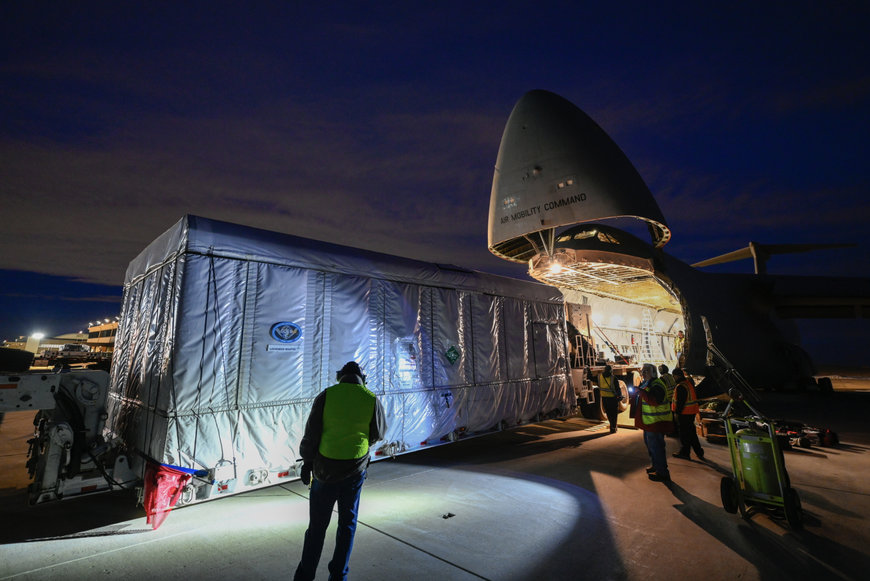www.aero-defence.tech
29
'24
Written on Modified on
Lockheed Martin News
NOAA’S NEWEST WEATHER SATELLITE FROM LOCKHEED MARTIN ARRIVES IN FLORIDA
GOES-U will enable the constellation to continue saving lives and property by ensuring forecasters have access to better-than-ever weather data for many years to come.

GOES-U is the final satellite to round out NOAA’s GOES-R series and is seen here being loaded for transport at Buckley Space Force Base in Aurora, Colorado. Credit: Lockheed Martin.
The next-generation Geostationary Operational Environmental Satellite (GOES)-U has successfully arrived at Kennedy Space Center, Florida, to begin preparing for its spring launch. It is the final of four satellites in the National Oceanic and Atmospheric Administration (NOAA)’s GOES-R weather satellite series, all built by Lockheed Martin in Littleton, Colorado.
These satellites provide meteorologists in the U.S. and western hemisphere with crystal-clear images of severe storms, hurricanes, wildfires and other weather hazards earlier than ever before.
Upon its arrival at Kennedy Space Center in Florida, teams then transported GOES-U to Astrotech Space Operations in Titusville, Florida – also a Lockheed Martin company. For the next several months, engineers there will ready the spacecraft for its launch, conducting activities like final testing, checkouts and encapsulation in its rocket fairing.
GOES-U is baselined for launch starting in April 2024.
What’s Next after GOES-R?
NOAA’s current GOES-R satellites revolutionized weather forecasting, with the first one transmitting more data in its first six months of operation than all previous GOES satellites combined. The program has brought significant benefits to North America and the global weather community by producing high-quality imagery that supports preparedness, climate monitoring, ecosystems management, agriculture, commerce and transportation.
NOAA’s next flagship weather program – called the Geostationary Extended Observations (GeoXO) satellite system – will expand these already robust weather observation capabilities. Its technology will be designed to address further challenges faced by humankind, like increased severe weather, emerging environmental issues and rising ocean temperatures driven by a rapidly changing climate.
More about the Mission
The GOES-R Series is a collaborative acquisition and development effort between NOAA and the National Aeronautics and Space Administration (NASA) to develop, launch and operate weather satellites. NOAA manages all GOES satellites and distributes their data to users worldwide, while NASA oversees the acquisition of the spacecraft and instruments, in addition to the management of the launch through NASA’s Launch Services Program.
In addition to building all four satellites in the GOES-R series, Lockheed Martin also produced two of the primary instruments aboard: the Geostationary Lightning Mapper and Solar Ultraviolet Imager. Once GOES-U completes an on-orbit checkout of its instruments, systems, and data products, NOAA plans to put GOES-19 into service as GOES East, replacing GOES-16. It will complete the group of GOES-R satellites in space: GOES-16 (currently GOES East), GOES-18 (GOES West) and GOES-17 (on-orbit spare).
The next-generation Geostationary Operational Environmental Satellite (GOES)-U has successfully arrived at Kennedy Space Center, Florida, to begin preparing for its spring launch. It is the final of four satellites in the National Oceanic and Atmospheric Administration (NOAA)’s GOES-R weather satellite series, all built by Lockheed Martin in Littleton, Colorado.
These satellites provide meteorologists in the U.S. and western hemisphere with crystal-clear images of severe storms, hurricanes, wildfires and other weather hazards earlier than ever before.
Upon its arrival at Kennedy Space Center in Florida, teams then transported GOES-U to Astrotech Space Operations in Titusville, Florida – also a Lockheed Martin company. For the next several months, engineers there will ready the spacecraft for its launch, conducting activities like final testing, checkouts and encapsulation in its rocket fairing.
GOES-U is baselined for launch starting in April 2024.
What’s Next after GOES-R?
NOAA’s current GOES-R satellites revolutionized weather forecasting, with the first one transmitting more data in its first six months of operation than all previous GOES satellites combined. The program has brought significant benefits to North America and the global weather community by producing high-quality imagery that supports preparedness, climate monitoring, ecosystems management, agriculture, commerce and transportation.
NOAA’s next flagship weather program – called the Geostationary Extended Observations (GeoXO) satellite system – will expand these already robust weather observation capabilities. Its technology will be designed to address further challenges faced by humankind, like increased severe weather, emerging environmental issues and rising ocean temperatures driven by a rapidly changing climate.
More about the Mission
The GOES-R Series is a collaborative acquisition and development effort between NOAA and the National Aeronautics and Space Administration (NASA) to develop, launch and operate weather satellites. NOAA manages all GOES satellites and distributes their data to users worldwide, while NASA oversees the acquisition of the spacecraft and instruments, in addition to the management of the launch through NASA’s Launch Services Program.
In addition to building all four satellites in the GOES-R series, Lockheed Martin also produced two of the primary instruments aboard: the Geostationary Lightning Mapper and Solar Ultraviolet Imager. Once GOES-U completes an on-orbit checkout of its instruments, systems, and data products, NOAA plans to put GOES-19 into service as GOES East, replacing GOES-16. It will complete the group of GOES-R satellites in space: GOES-16 (currently GOES East), GOES-18 (GOES West) and GOES-17 (on-orbit spare).
www.lockheedmartin.com

